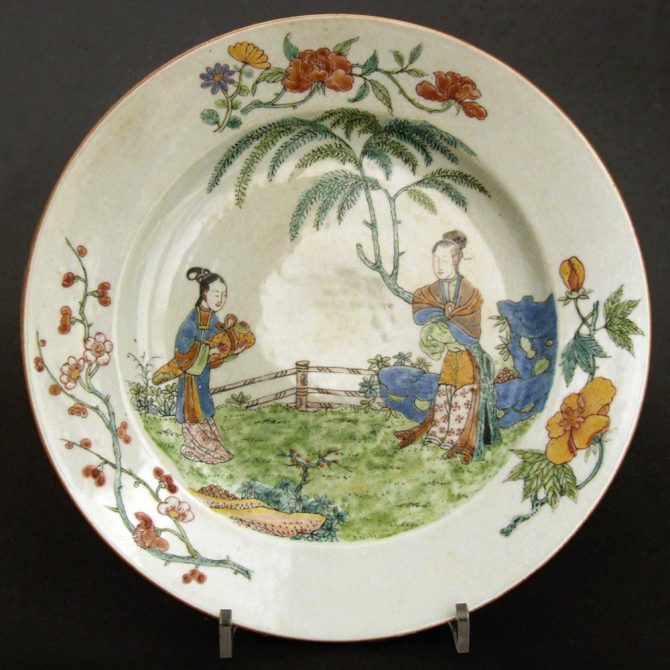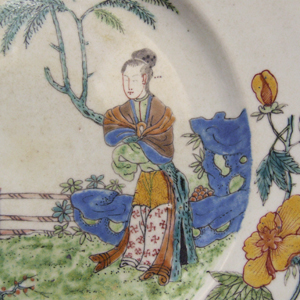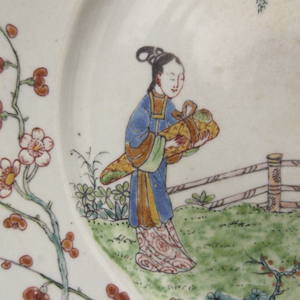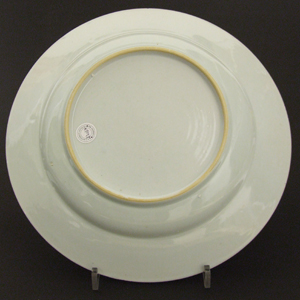
YONGZHENG 1723 – 1735 Dutch Decorated Chinese Porcelain
A Rare Dutch Re-Decorated Chinese Export Porcelain Dish, Yongzheng Period 1723-1735, Decorated in Holland in c.1730 – 1740. Entirely Painted in Holland in the Style and Palette of Early Famille Rose Porcelain with Two Well Dressed Figures in a Garden Landscape. A Lady on the Right Receives a Guqin (See below) Wrapped in Cloth from a Female Servant. The Original Chinese Decoration has Been Totally Erased but is Viable Due to a Feint `Shadow` of the Original Design Showing. This Appears to been of Simple Scattered Flower with Diaper Border.
SOLD
- Condition
- Very good, a minute glaze chip to the rim c.2 mm and a few minute glaze chips to the back of the rim, the largest c.2 mm.
- Size
- Diameter : 27.8 cm (11 inches).
- Provenance
- N/A
- Stock number
- 22037
Information
Re-Decorated Chinese Porcelain :
For convenience it might be practical to divide European decoration of Chinese export porcelain into three groups. Firstly where the European decoration had been used to augment the existing Chinese enamel, blue and white or incised decoration, see stock number 21823 for an example. This was used to enliven designs that were rather plain or indeed sometimes where the Chinese porcelain was undecorated to start with. The second group can be termed `over-decorated`, where the European enamelling was added partly or wholly on top of the existing Chinese enamels, sometimes taking no notice of the original design, see stock number 21567 for an example. The last and by far the least common, where the original Chinese enamels have been partly or entirely removed so as to leave some space or a `blank canvas` for the European decorator. Chinese porcelain with European decoration is rarely encountered where the whole of the original design has been removed because it must have been a very laborious and expensive solution to improving the object, stock number 22037 is the only example were have had. The point of adding European decoration was, of cause, to increase the desirability of the Chinese porcelain object and so increase the profit of the merchant. One of these techniques would have be selected to improve the saleability of the porcelain by making it more attractive and more in keeping with current fashions.
Qin or Guqin :
Guqin is the modern name for a plucked seven-string Chinese musical instrument of the zither family. It has been played since ancient times, and has traditionally been favoured by scholars and literati as an instrument of great subtlety and refinement, as highlighted by the quote "a gentleman does not part with his qin or se without good reason," as well as being associated with the ancient Chinese philosopher Confucius. It is sometimes referred to by the Chinese as "the father of Chinese music" or "the instrument of the sages". Traditionally the instrument was called simply qin but by the twentieth century the term had come to be applied to many other musical instruments as well: the yangqin hammered dulcimer, the huqin family of bowed string instruments, and the Western piano are examples of this usage. The prefix "gu-" (meaning "ancient") was later added for clarification. It can also be called qixianqin (lit. "seven-stringed instrument"). The guqin is not to be confused with the guzheng, another Chinese long zither also without frets, but with moveable bridges under each string. Because Robert Hans van Gulik`s famous book about the qin is called The Lore of the Chinese Lute, the guqin is sometimes inaccurately called a lute.


